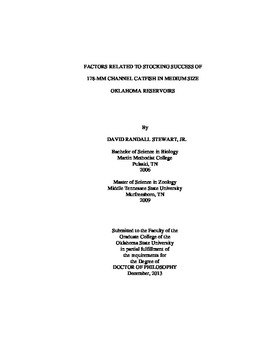| dc.contributor.advisor | Long, James M. | |
| dc.contributor.author | Stewart, David Randall, Jr. | |
| dc.date.accessioned | 2015-06-17T20:08:09Z | |
| dc.date.available | 2015-06-17T20:08:09Z | |
| dc.date.issued | 2013-12 | |
| dc.identifier.uri | https://hdl.handle.net/11244/15136 | |
| dc.description.abstract | The channel catfish Ictalurus punctatus is a commonly stocked freshwater fish species. Prior studies indicate that stocking advanced size (> 150 mm total length (TL)) fingerlings increases post-release survival but few studies have identified factors that influence stocking success. The present study was conducted to determine stocking contribution and growth of advanced size channel catfish (~178 mm TL), evaluate the impact of stocking and cessation of stocking, quantify habitat relationships, and evaluate trophic relationships of wild and stocked fish in medium size Oklahoma reservoirs: lakes McMurty and Ponca (control lakes), Okemah and Okmulgee (cease-stock lakes), and Greenleaf and Lone Chimney (stocked lakes). Channel catfish were immersed in a buffered solution of oxytetracycline (OTC) and stocked in October 2010 at lakes Greenleaf and Lone Chimney. The higher relative abundance of resident channel catfish in Lake Lone Chimney may have affected survival and growth of stocked fish. Stocking contribution at Lake Lone Chimney was low (~30%) compared to Lake Greenleaf (~98%). Fish stocked in Greenleaf reached an average length of 348 mm two years poststock, whereas fish stocked in Lone Chimney grew to 240 mm, an increase by only 62 mm since stocking. To evaluate the full impact of stocking, two reservoirs were no longer stocked as part of an experimental manipulation. Relative abundance, growth, and size structure responded as expected. Cessation of stocking resulted in lower relative abundance, increased growth rates, and larger size structure. Whereas relative abundance increased for one stocked lake (Greenleaf), mean length at age and growth decreased, and size structure shifted to smaller size fish. Results from the multi-scale models indicate significant associations with both near-shore and land-use habitat types. Channel catfish were found at higher abundances in turbid areas with rock and coarse-woody debris, and a negative relationship was evident with aquatic vegetation, residential development and agriculture land-use. Trophic relationships indicated that intra-specific competitive interactions were evident. These results provide further evidence that density-dependent mechanisms likely reduced both survival and growth of stocked fish in Lake Lone Chimney. It also suggests that both habitat and relative stock size should be considered before stocking advanced size fingerlings. | |
| dc.format | application/pdf | |
| dc.language | en_US | |
| dc.rights | Copyright is held by the author who has granted the Oklahoma State University Library the non-exclusive right to share this material in its institutional repository. Contact Digital Library Services at lib-dls@okstate.edu or 405-744-9161 for the permission policy on the use, reproduction or distribution of this material. | |
| dc.title | Factors related to stocking success of 178-mm channel catfish in medium size Oklahoma reservoirs | |
| dc.contributor.committeeMember | Shoup, Daniel E. | |
| dc.contributor.committeeMember | Brewer, Shannon K. | |
| dc.contributor.committeeMember | Goad, Carla L. | |
| osu.filename | Stewart_okstate_0664D_13118.pdf | |
| osu.accesstype | Open Access | |
| dc.type.genre | Dissertation | |
| dc.type.material | Text | |
| dc.subject.keywords | advanced size fingerlings | |
| dc.subject.keywords | channel catfish | |
| dc.subject.keywords | experimental manipulation | |
| dc.subject.keywords | multi-scale models | |
| dc.subject.keywords | oxytetracycline | |
| dc.subject.keywords | stock enhancement | |
| thesis.degree.discipline | Natural Resource Ecology and Management | |
| thesis.degree.grantor | Oklahoma State University | |
